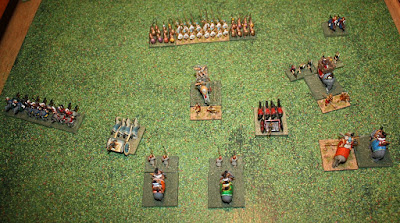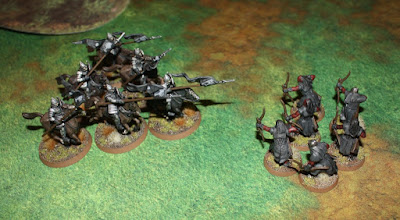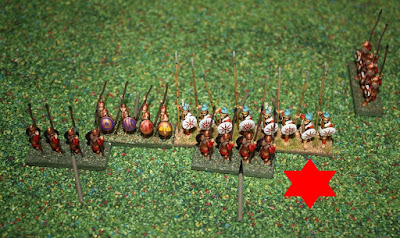This is game 28 in play testing my ancient rules by replaying historical battles. The latest version of ‘Ancient Battlelines Clash’ is on its own blog page. I am play testing the rules by replaying all the Peter Sides scenarios from his Historical Battles books. ABC is designed to finish in under an hour on a 2'x2' table.
Battle of Ipsus
In the saga of the Successor Wars, Antigonus One-Eye and his son Demetrius face a coalition of three other Successor emperors – Seleucus, Cassander and Lysimachus. The three had banded together as they were likely to be destroyed by Antigonus piecemeal otherwise. This was the last real chance for Antigonus to reunite Alexander’s empire.
There is not much on the internet on this battle:
Scenario
changes
Reduced by about a three-quarters the troops due to my smaller sized table.
I also roughly halved the Spear or pike units as the scenario units are for DBx that
assumes in this case that the units will be rear supported, not the case with
my rules. I also put a bit more cavalry on the Antigonid right flank as the limited information on the battle seems that there was more cavalry here with Demetrius, compared to the Allies that may have evenly distributed the cavalry. I also put an elephant on the Antigonid left flank and centre, while the Peter Sides Scenario had elephants on the left and right flank.Troops
Diodachi Allies (Seleucus, Cassander's brother Pleistarchus and Lysimachus)
4 Phalangites, battle infantry, phalanx
2 Peltasts, aux infantry
1 Psiloi, skirmish infantry, short missile
1 Heavy Cavalry, aux cavalry, high fortitude
1 Heavy Cavalry, aux cavalry
2 Light Cavalry, skirmish cavalry, long missile
4 Elephants, elephant
2 Scythed Chariots
1 General with Guards
Breakpoint: 12
Antigonus
2 Phalangites, battle infantry, phalanx
2 Hoplite, battle infantry, phalanx, some protection
2 Peltasts, aux infantry
2 Psiloi, skirmish infantry, short missile
2 Elephant, elephant
1 Guard Cavalry, aux cavalry, high fortitude
1 Heavy Cavalry, aux cavalry
2 Light Cavalry, skirmish cavalry, short missile
1 General with a phalangite.
Breakpoint: 10
I thought about using subgenerals to represent the sons/generals on each side and have the general in the centre. With the small number of units, I decided against this and to put one general on each side - Antigonus in the centre and a guess that the main allied general is on their right wing cavalry.
Deployment
Deployment:
 |
| Allies to the left, Antigonus on the right |
The Game
The Allies advance the elephants and scythed chariots.
 |
| Allied advances |
 |
| Antigonus advances (view from the Allied side) |
 |
Allied elephants (on left) on the allied right flank
|
This is why I wrote Ancient Battlelines Clash - all of the above driven by the rules - fast, a little unpredictable but still producing a great narrative with just a few dice rolls.
 |
| The result of sending in the Allied elephants (a lot of skimisher casualties) |
Scythed chariots hit the hoplites, disorder them but are destroyed in return
 |
| Scythed Chariots - at least they caused a disorder |
Elephant and skirmishers meet in the centre but all that happened is the Allied skirmishers cleared the opposing skirmishers.
 |
| Battle of elephant and skirmishers in the centre. |
 |
| The second Allied elephant joins the fray in the centre |
 |
| The second scythed chariot throws itself at the phalanx line for no effect before being destroyed. |
 |
| On the Antigonid right flank, Demetrius meets the opposing cavalry. |
 |
| Elephant battle continues in the centre, clearing out the skirmishers. It is tusk on tusk now. |
 |
| On the Allied right flank, both Allied elephants are routed by opposing light infantry |
In a case of brilliant and poor dice rolling,the Antigonid right flank sees one the the Antigonid heavy cavalry routed, but also the lone Allied cavalry as well. Demetrius pursues to near the table edge.
 |
| Demetrius routs the opposing heavy cavalry, but losing one of his heavy cavalry as well. |
 |
| An Allied elephants makes it into a Antigonid phalanx and disorders them before routing. |
 |
| The other Allied elephant makes it into another Antigonid phalanx and disorders them before routing |
 |
| Overview of the battle after the initial flank battles and centre skirmishing |
The Allies are near their breakpoint (losing 4 elephants and a heavy cavalry) while the Antigonids are still far away from it (losing only one elephant and heavy cavalry). but now the phalanxes are going to meet...
The moment we have all been waiting for - the phalanx lines meet. The Antigonids have three disordered phalanxes (not good). The undisordered one has Antigonus with them (that is good).
 |
| Phalanx battlelines clash. three of the Antigonid phalanxes (rear) are at a disadvantage as they are disordered. But the undisordered one has Antigonus with them. |
 |
| Two of the disordered Antigonid phalanxes rout. Demetrius can bee seen botton centre |
 |
| Antigonus routs an opposing Allied phalanx |
 |
| End game. Antigonid victory |
Alternative history - the Allies won this one in reality.
Verdict
I thought about not using so many elephants, but they were important to the original battle's outcome, so I used quite a few. They tend to get routed early - before the main battlelines clash - and this did cause the Allies to get close to their breakpoint. It was fine, although there usually only been a couple of skirmisher-elephant clashes in other battles, this one had lots and it does slow the game game slightly. Normally skirmishers are one or two-shot units before retiring from the game.




























































.webp)







































.jpg)



